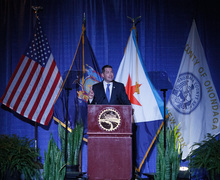‘Do you hear us?’: Residents call for changes in policing
India Miraglia | Asst. News Editor
About 200 residents packed into the gymnasium at St. Lucy’s Church on Friday night.
One after another, Syracuse residents stood in front of the gymnasium at St. Lucy’s Church. They spoke about family members and friends who had been injured and even killed by Syracuse police. They expressed concerns about the way the Syracuse Police Department interacts with the community.
In front of them stood Police Chief Kenton Buckner, Mayor Ben Walsh and other officials who arranged the Friday night forum to discuss SPD’s revised use of force policy. Buckner began the forum with a presentation of what the new use of force policy entails, but tensions in the auditorium rose quickly. Audience members would often speak out over Buckner and Walsh, passionate about sharing their experiences, worries and fears.
Alexandra Makki stood in front of the auditorium and directed a question to the officials. “Do you hear us?” she asked. “We are telling you our stories.”
Syracuse community members urged SPD to revise and release its use of force policy after a viral video was posted on Instagram in May showing the forceful arrest of Shaolin Moore, 23, of Syracuse. Both the Instagram video and police body camera footage showed SPD officer Christopher Buske grabbing Moore by the neck and pulling him from a vehicle after he refused to get out. Buske is seen striking Moore with a closed fist, and several officers restrain Moore on the ground.
An SPD internal affairs investigation found that the two officers involved in the arrest did not use excessive force. The investigation did conclude that the officers used vulgar language during the arrest that was in violation of the department’s demeanor policy.
Those who attended Friday night’s forum expressed discontent and frustration with the way the officers handled Moore’s arrest and with the results of the investigation. Residents said they were concerned that, even with an updated policy, officers would use excessive force without facing consequences. They called on Buckner to do more to change the way officers interact with residents and to address past incidents of police violence.
The new policy combines use of deadly force and use of physical force — separated in the previous policy — into one section that establishes when force can be used. One audience member said she became “scared to death” when she saw that change. Many audience members said they feared interacting with police. Talina Jones, a local activist, also said it is “everyday use of force” that breaks the trust of a community.
The updated policy states that “the reasonableness of force will be judged from the perspective of a reasonable officer on the scene at the time of the incident.” Jones said past actions of SPD officers have shown the community that officers can not be trusted to make “reasonable” decisions with community members.
“I’ve listened to multiple people behind me talk about white supremacist, racist actions against people in the community that they live in. And so, we don’t trust your understanding of reasonableness,” Jones said. “We don’t believe you. No one believes you right now.”
A separate policy section will be created for guidelines on reporting and investigating use of force. In response to a question about what punishment an officer could receive for violating the new use of force policy, Buckner said it ranged from counseling to termination.
Revisions to the use of force guidelines also ban chokeholds unless there is an immediate threat of serious harm or death, prohibits the use of force on someone in restraints unless to prevent harm and forbids officers from firing warning shots.
Various sources were used to build the updated policy, including national use-of-force data, recommendations from Syracuse’s Citizen Review Board and the use of force policy in Little Rock, Arkansas, where Buckner previously served as chief.
The new policy will go into place on July 11, Walsh said at the forum. Other meetings will be held to discuss the policy, with the next one scheduled for July 28. At Friday’s forum, however, residents’ concerns extended to more than just the makeup of the use of force policy. Many said SPD officers participated in racial profiling and were intentionally violent and harmful to communities of color in Syracuse.
Multiple times throughout the night people asked what percent of use of force incidents involved people of color — Buckner said he didn’t have the data. But he did present yearly data on how many arrests resulted in use of force complaints and what percent of allegations ended in reprimanding an officer. Last year saw 13,457 arrests with 428 use of force reports. A little more than 3% of those reports were found to be actual cases of excessive force, according to Buckner’s data.
Buckner said SPD needs a record management system available to the public that shows who is being arrested. Both he and Walsh said they will use the comments, stories and concerns shared on Friday to inform future measures and decisions. Many residents asked if the chief and mayor were listening to their concerns, and each time they promised they were.
“It’s important that we hear these kind of things,” Bucker said. “More important, that we do something about it.”
Published on June 29, 2019 at 12:40 am
Contact India: irmiragl@syr.edu





